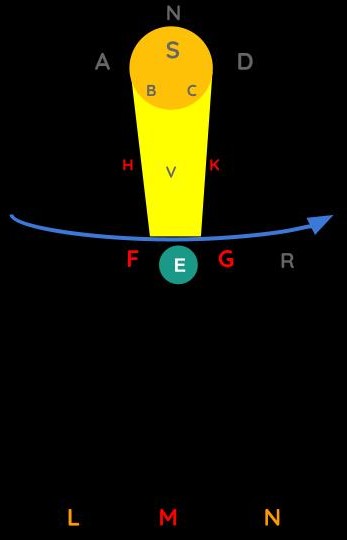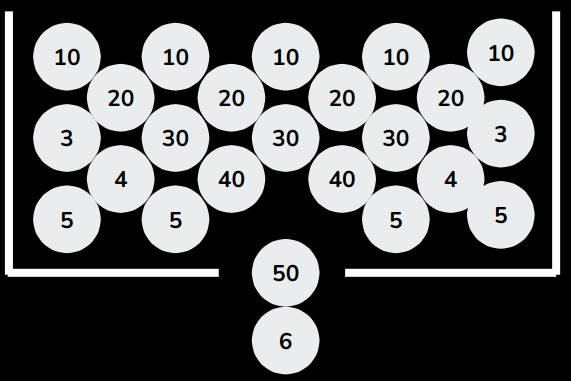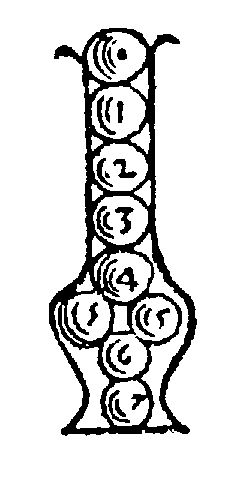The Properties of Light
Table of Contents
Light pushes on our eyes. The principal properties of light are:
The Movement of Light
- It travels in all directions around “luminous” bodies
This is due to the circular motion of their particles.
- It travels to any distance
If the air-aether between AF and DG are already disposed to advance towards E, the force with which the sun pushes those at ABCD should also extend out to E.

This is even though there is a greater distance from the one to the other than there is from the highest stars of the firmament down to us.
- It travels instantly
The air-aether particles between AF and DG all touch and press one another as much as possible.
The push on the first ones must pass in an instant out to the last one.
This is the same as:
- the force that pushes one end of a stick passes to the other end at the same instant.
- Ball
50falls toward ball6. The10balls also fall towards the ball6at the same instant.

- It travels ordinarily in straight lines, as rays of light
This straight-line motion is different from the straight-line motion of the air-aether which is its medium. Such a medium is immaterial. But it designates only in what direction and according to what determination the luminous body acts on the body it is shining on.
Thus, the lines of light are exactly straight even though its air-aether medium do not completely form straight lines.
This is similar to hand A pushing the body E along the straight line AE even though it pushes it with a twisted stick BCD.

In the same way, Ball 1 pushes Ball 7 through Balls 5, as directly as through the other balls.

Source and Destination of Light
-
These rays coming from diverse points can come together at the same point
-
These rays from the same point can go out toward different points
Several of them come from the points A, B, C, D and come together at point L.

Several come from the single point D and extend, one toward E, another toward K, and thus toward an infinity of other places.
In the same way, the diverse forces with which one pulls the cords 1, 2, 3, 4, 5 all come together in the pulley.

The resistance of this pulley extends to all the diverse hands that are pulling those cords.
- These rays coming from diverse points and going toward diverse points, can pass through the same point without impeding one another
The two rays AN and DL pass through point E. The air-aether can receive several diverse motions at the same time.
Thus, the air-aether at point E can be pushed as a whole toward L by the action coming from D near the sun and, at the same time, towards N by that coming from A.
Through the three tubes FG, HI, and KL, one can push the air at the same time from:
FtowardsGHtowardsIKtowardsL

Those tubes are joined at point N so that all the air that passes through the middle of each of them also passes through the middle of the other two.
- They can also sometimes impede one another
This happens when their force is very unequal. Strong light impedes the effect of those that are weaker.
If one pushes the air much more strongly F through than through H or through K, it will not tend at all toward I or toward L, but only toward G.
Refraction and Reflection
-
They can be diverted by reflection
-
They can be diverted by refraction
I explained reflection and refraction through an [60] example of the motion of a ball instead of rays of light.
The only difference between the ball and light is that it requires time for the ball to travel. Whereas the light can travel in an instant.
When the rays of light get reflected when they meet a body that does not permit them to pass. This is like a ball being reflected when it strikes a wall.
Light get refracted in water just as a ball enters or leaves a body of water obliquely.
When they enter obliquely some place through which they can extend more or less easily than they can through that from which they are coming, they must also be diverted and undergo refraction at the point of that change.
The Force of Light
-
Their force can be increased
-
Their force can be diminished
This is done by the diverse dispositions or qualities of the matter that receives them.
The force of light is not only more or less great in each place according to the quantity of the rays that come together there, but it can also be increased or diminished by the diverse dispositions of the bodies in the places through which it passes.
In the same way, the speed of a ball or a stone one is pushing in the air can be increased by winds blowing in the same direction that it is moving and diminished by their contraries.